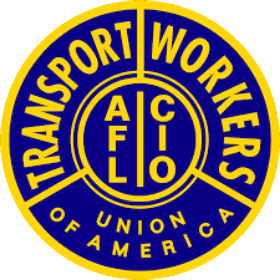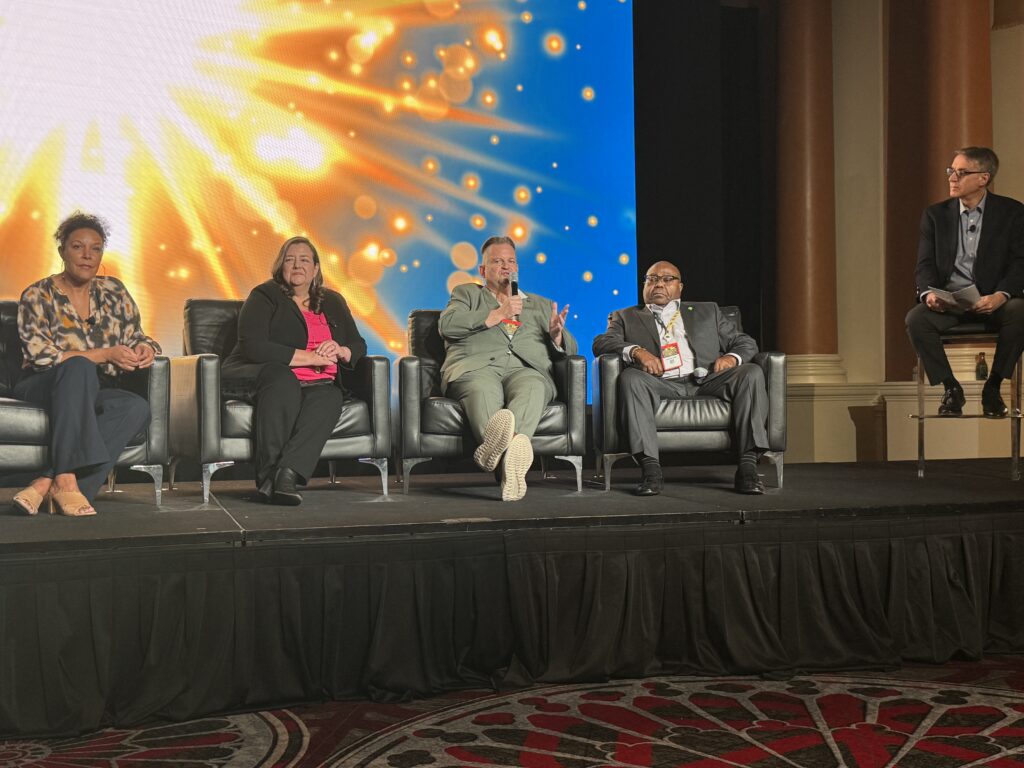This is the monthly edition of the Transport Workers Union’s Transportation Technology Newsletter. We aim to inform and educate our members, the labor movement, the public and policymakers about developments in transportation technology – and what the TWU is doing to ensure that new technology doesn’t undermine safety or harm the livelihoods of hard-working blue-collar workers. For suggestions and questions, please email ewytkind@gmail.com or adaugherty@twu.org.
ITEM OF THE MONTH
BUILDING COALITIONS: The TWU’s 27th Constitutional Convention last month included a critical discussion of technology issues across the labor movement – with leaders from the Transport Workers Union and Screen Actors Guild–American Federation of Television and Radio Artists discussing their ongoing efforts to fight big tech in the transportation and entertainment sectors.
TWU International President John Samuelsen and Administrative Vice President Curtis Tate sat down with SAG-AFTRA Executive Vice President Linda Powell and Chief Labor Policy Officer and New York Local Executive Director Rebecca Damon for a discussion moderated by Ed Wytkind. Samuelsen said that successful fights on tech issues like the expansion of autonomous transportation systems and on entertainment issues like AI being used to replace working actors start with winning good contracts.
“We’re fighting back, we’re developing contract language, we’re about to go through this in so many cities as the next four years go by,” Samuelsen said. “It began in transit and it began in rail but it is coming to the airlines quickly. We need to organize, develop contract language and develop the internal power to win that contract language.”
In entertainment, Powell noted that major streaming services like Netflix and Amazon were trying to create digital likenesses of creative professionals in an attempt to cut labor costs. SAG-AFTRA, with support from the TWU, successfully fought against these efforts during a 2023 strike.
“Automation for us is digitization,” Powell said. “We discovered they were in a position where they could come up with technologies where they digitize our voices, create digital replicas of us so our work was at risk of being taken over by images of ourselves. They had the ability to replace us with ourselves.”
Tate added the human factor of transportation workers being physically present on a bus or train is a significant benefit for the traveling public, both for safety purposes and for having a pair of essential eyes and ears in the community. He also noted that the heroic actions of TWU members in New York in the hours and days after 9/11 would not have been possible with an automated transportation system. In one instance, TWU Train Operators stopped to pick up passengers stranded in Lower Manhattan right after the attack, ignoring orders not to stop. “The computer would have left them there,” Tate said.
“Every time you look at the news, read the papers, there’s always an instance where some bus operators, some worker, or some human being did something heroic,” Tate said.
The discussion is another instance of the TWU working across the labor movement to raise awareness about the dangers of unfettered technology on workers everywhere – regardless if they are working on the rails or in a Broadway production. The TWU will continue to fight for all of our members as we witness the expansion of autonomous transportation while supporting our brothers and sisters across the labor movement against monied interests seeking to gut good jobs.
Watch the entire conversation between TWU and SAG-AFTRA here.
WHAT ELSE IS COOKING
NEW YORK NIGHTMARE: Waymos hit the streets of New York in August – a major threat to the traveling public and TWU members in America’s densest urban environment. Earlier this month, Waymos, with the support of beleaguered mayor Eric Adams, were given the green light to continue testing through the end of the year, Tech Brew reports. The TWU raised public awareness of the challenges that Waymo poses for NYC streets.
“Waymo will turn pedestrians into cannon fodder and will block streets for emergency responders,” Samuelsen said. “Waymo isn’t ready for NYC’s streets and the end goal is to replace rideshare drivers, taxi drivers, and transit workers with robots.”
Tate also warned against the expansion of autonomous vehicles to NYC streets in a New York Daily News op-ed last year. The company, which has primarily operated in California or throughout the South, admitted earlier this year in Boston that its vehicles are not prepared to drive in wintry conditions.
“New York is America’s most densely populated big city. There’s a dizzying amount of activity from an unmatched number of pedestrians, bicyclists, pedicabs, and motorists,” Tate wrote. “Pedestrians cross streets in Manhattan like nowhere else in the country. They do whatever they want, whenever they want. These vehicles are not prepared to deal with that kind of pedestrian interaction.”
And Waymo isn’t stopping with rideshare. The Verge reports that Waymo robotaxis will be integrated with Chandler, Arizona’s public transportation system. For now, the rides will mostly be used for microtransit service, connecting riders with bus routes.
“This is exactly the playbook Big Tech plans to use with transportation networks,” Tate said. “First, they start with rideshare drivers, then they move onto paratransit networks. We know what the end game is – a transportation network that is devoid of human operators and their expertise.”
NO STOPPING A FREIGHT TRAIN: It appears that Tesla’s “full self-driving,” or FSD, can’t recognize a train crossing – that, according to a Tesla driver interviewed by NBC News, whose story in North Texas captures the dangerous incidents on video.
Railroad crossing arms were descending and the Tesla driver, more than once, had to abruptly stop the car a few feet from the crossing as a train approached the intersection. “It felt like it was going to run through the arms,” the driver said. “So obviously I just slammed on the brakes.” NBC News says it interviewed six Tesla drivers who reported experiencing the same problems at rail crossings with four providing videos. On Reddit, X and YouTube NBC News discovered 40 similar stories since 2023.
Sens. Edward Markey (D-Mass.) and Richard Blumenthal (D-Conn.) jumped in, calling on NHTSA regulators to investigate these Tesla rail crossing incidents, in the wake of regulators opening a broader investigation into Tesla’s FSD system affecting almost 3 million cars amidst 58 safety violations such as running through red traffic signals and making lane changes into opposing traffic. CBS News, citing NHTSA, reported these incidents resulted in “more than a dozen crashes and fires” and “23 injuries.”
“Because collisions between trains and cars often cause significant fatalities and injuries, FSD’s failure to safely navigate railroad crossings creates serious risk of a catastrophic crash,” the senators wrote. “We urge NHTSA to immediately launch a formal investigation into this disturbing safety risk and take any necessary action to protect the public.”
THINK OF THE CHILDREN: While Waymo constantly brags about its safety record, one of its robocars illegally failed to stop for an Atlanta school bus as kids were disembarking, an incident that has led local officials to call for new safety laws. The current penalty in this Atlanta county for failing to stop for a school bus is up to $1,000 and possible jail time.
“The majority of our traffic laws come with penalties like fines or driver’s license suspension,” said Georgia State Representative Clint Crowe, who sponsored the law that set new penalties for these safety violations. “These cars don’t have drivers or licenses, so we really have to rethink who is responsible. Who’s in control or the vehicle? Who’s the operator?” Crowe also argued that autonomous vehicle manufactures should face stronger consequences and increased fines.
State Senator Rick Williams went further. “Driverless cars should be stopped until [this] can be figured out. It’s too dangerous for our children,” he said, adding that he plans to beef up penalties for traffic safety violations against companies like Waymo.
“TWU has argued that these poorly regulated zombie robotaxis are a menace on our roads – and now we see they can’t even comply with traffic safety laws designed to protect kids on school buses,” Tate said. “No thanks – transportation is a human-centric business. State and local officials should stop enabling unsafe autonomous vehicles and instead focus on bringing technologies into their cities that make transportation safer.”
AUTONOMOUS SHUTTLE IN JACKSONVILLE: More than a dozen autonomous electric vehicles will launch revenue service in the Jacksonville Transportation Authority (JTA), initially along a 3.5 mile route serving 12 stations. While initial pilots included an operator in the vehicle, it isn’t clear if drivers will remain on-board in the future. Mobility company Beep will oversee operations of the system including an autonomous command center that will “store, service, monitor and maintain” the city’s autonomous vehicles.
Beep says the command center will keep a “human in the loop” who will assist vehicles when they malfunction. The 9-passenger Ford e-Transit vehicles will deploy driverless technology engineered by Oxa.
WHAT WE’RE READING:
Amazon’s Zoox Jumps Into Robotaxi Sector. CNBC.
China Continues Global Autonomous Vehicle Expansion. Global Times.
Anti-Drunken Driving Tech? Government and Technology.
Waymo Coming to London. The Guardian.
Georgia Tech, NASA Collaborate on Autonomous Flight Project. WALB News.

